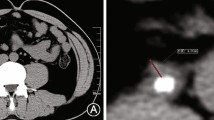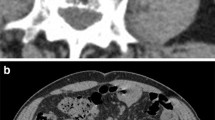Abstract
The purpose of the study was to investigate variables that may predict ureteral stone impaction and create a new model to predict more accurately stone impaction based on preoperative NCCT findings. Data of 238 patients who underwent URS were analyzed. Stone size, stone location, Hounsfield unit (HU) value of the stone, ureteral wall thickness (UWT) and grade of hydronephrosis were recorded. HU values of the ureter which are measured proximal and distal to the stone were recorded. Subsequently, we determined the factors that could predict the stone impaction in univariate and multivariate logistic regression analysis. After the AUC analysis for these factors, we created a new model to predict more accurately stone impaction. The formula was named Impacted Stone Formula (ISF). Stone impaction verified endoscopically. Predictors of impacted stones were evaluated using univariate and multivariate logistic regression analyses. Diagnostic value for the prediction of stone impaction was analyzed with receiver operating characteristic (ROC) incline. Overall, there were 196 patients included in the study. Multivariate regression analysis revealed that the HU below/above ratio, UWT, and grade of hydronephrosis were the crucial predictors of stone impaction (OR 20.53, p < 0.001; OR 10.55, p < 0.001; OR 5.95, p = 0.004, respectively). The ROC analysis revealed a cutoff value of 15.15 (AUC 0.958, p < 0.001, sensitivity 91.0%, specificity 97.7%) for the ISF. In conclusion, ISF is the most precise preoperative predictor of impacted stones in patients with ureteral stones. ISF could be used by the urologists before treatment to help preoperative planning and perioperative clinical course.



Similar content being viewed by others
Abbreviations
- AUC:
-
Area under curve
- BMI:
-
Body mass index
- CT:
-
Computed tomography
- HU:
-
Hounsfield unit
- ISF:
-
Impacted stone formula
- NCCT:
-
Non-contrast computed tomography
- OR:
-
Odds ratio
- ROC:
-
Receiver operating characteristic
- SWL:
-
Shock wave lithotripsy
- URS:
-
Ureterorenoscopy
- UWT:
-
Ureteral wall thickness
References
Morgentaler A, Bridge SS, Dretler SP (1990) Management of the impacted ureteral calculus. J Urol 143:263–266. https://doi.org/10.1016/S0022-5347(17)39928-7
Seitz C, Tanovic E, Kikic Z, Fajkovic H (2007) Impact of stone size, location, composition, impaction, and hydronephrosis on the efficacy of holmium:YAG-laser ureterolithotripsy. Eur Urol 52:1751–1759. https://doi.org/10.1016/j.eururo.2007.04.029
Chaussy CG, Fuchs GJ (1989) Current state and future developments of noninvasive treatment of human urinary stones with extracorporeal shock wave lithotripsy. J Urol 141:782–789. https://doi.org/10.1016/S0022-5347(17)41010-X
Goel R, Aron M, Kesarwani PK et al (2005) Percutaneous antegrade removal of impacted upper-ureteral calculi: still the treatment of choice in developing countries. J Endourol 19:54–57. https://doi.org/10.1089/end.2005.19.54
Degirmenci T, Gunlusoy B, Kozacioglu Z et al (2012) Outcomes of ureteroscopy for the management of impacted ureteral calculi with different localizations. Urology 80:811–815. https://doi.org/10.1016/j.urology.2012.05.007
Sarica K, Kafkasli A, Yazici Ö et al (2014) Ureteral wall thickness at the impacted ureteral stone site: a critical predictor for success rates after SWL. Urolithiasis 43:83–88. https://doi.org/10.1007/s00240-014-0724-6
Yoshida T, Inoue T, Omura N et al (2017) Ureteral wall thickness as a preoperative indicator of impacted stones in patients with ureteral stones undergoing ureteroscopic lithotripsy. Urology 106:45–49. https://doi.org/10.1016/j.urology.2017.04.047
Fernbach SK, Maizels M, Conway JJ (1993) Ultrasound grading of hydronephrosis: introduction to the system used by the society for fetal urology. Pediatr Radiol 23:478–480. https://doi.org/10.1007/BF02012459
Yamaguchi K, Minei S, Yamazaki T et al (1999) Characterization of ureteral lesions associated with impacted stones. Int J Urol 6:281–285. https://doi.org/10.1046/j.1442-2042.1999.00067.x
Legemate JD, Wijnstok NJ, Matsuda T et al (2017) Characteristics and outcomes of ureteroscopic treatment in 2650 patients with impacted ureteral stones. World J Urol 35:1497–1506. https://doi.org/10.1007/s00345-017-2028-2
Baerlocher MO, Asch M, Myers A (2010) Allergic-type reactions to radiographic contrast media. CMAJ 182:1328. https://doi.org/10.1503/cmaj.090371
Hounsfield GN (1980) Computed medical imaging. Nobel lecture, Decemberr 8, 1979. J Comput Assist Tomogr 4:665–674
Zeb I, Li D, Nasir K et al (2012) Computed tomography scans in the evaluation of fatty liver disease in a population based study. The multi-ethnic study of atherosclerosis. AcadRadiol 19:811–818. https://doi.org/10.1016/j.acra.2012.02.022
Pickhardt PJ, Pooler BD, Lauder T et al (2013) Opportunistic screening for osteoporosis using abdominal computed tomography scans obtained for other indications. Ann Intern Med 158:588–595. https://doi.org/10.7326/0003-4819-158-8-201304160-00003
Bruni SG, Patafio FM, Dufton JA et al (2013) The assessment of anemia from attenuation values of cranial venous drainage on unenhanced computed tomography of the head. Can Assoc Radiol J 64:46–50. https://doi.org/10.1016/j.carj.2011.08.005
Ouzaid I, Al-qahtani S, Dominique S, Hupertan V, Fernandez P, Hermieu J, Delmas V, Ravery V (2012) A 970 Hounsfield units (HU) threshold of kidney stone density on non-contrast computed tomography (NCCT) improves patients’ selection for extracorporeal shockwave lithotripsy (ESWL): evidence from a prospective study. BJU Int 110:E438–E442. https://doi.org/10.1111/j.1464-410X.2012.10964.x
Tanidir Y, Sahan A, Asutay MK et al (2017) Differentiation of ureteral stones and phleboliths using Hounsfield units on computerized tomography: a new method without observer bias. Urolithiasis 45:323–328. https://doi.org/10.1007/s00240-016-0918-1
Yuruk E, Tuken M, Sulejman S et al (2017) Computerized tomography attenuation values can be used to differentiate hydronephrosis from pyonephrosis. World J Urol 35:437–442. https://doi.org/10.1007/s00345-016-1888-1
Turk C, Petrik A, Sarica K et al (2015) EAU guidelines on urolithiasis. Eur Assoc Urol 69:475–482. https://doi.org/10.1159/000049803
Ordon M, Schuler TD, Ghiculete D et al (2012) Stones lodge at 3 sites of anatomic narrowing in the ureter—clinical fact or fiction? J Endourol 27:120917133301000. https://doi.org/10.1089/end.2012.0201
Seitz C, Memarsadeghi M, Fajkovic H, Tanovic E (2008) Secondary signs of non-enhanced ct prior to laser ureterolithotripsy: is treatment outcome predictable? J Endourol 22:415–418. https://doi.org/10.1089/end.2007.0248
Kim JW, Chae JY, Kim JW et al (2014) Computed tomography-based novel prediction model for the stone-free rate of ureteroscopic lithotripsy. Urolithiasis 42:75–79. https://doi.org/10.1007/s00240-013-0609-0
Sarica K, Eryildirim B, Sahin C et al (2016) Impaction of ureteral stones into the ureteral wall: is it possible to predict? Urolithiasis 44:371–376. https://doi.org/10.1007/s00240-015-0850-9
Türk C, Neisius A, Petrik A et al (2017) European Association of Urology guidelines on urolithiasis 2017. http://uroweb.org/guideline/urolithiasis/. Accessed 20 June 2017
Mugiya S, Ozono S, Nagata M, Takayama T, Nagae H (2006) Retrograde endoscopic management of ureteral stones more than 2 cm in size. Urology 67:1164–1168
Ramakumar S, Segura JW (2001) When not to use shock wave lithotripsy for ureteral stones. Contemp Urol 13:54–65
Sahin C, Eryildirim B, Kafkasli A et al (2015) Predictive parameters for medical expulsive therapy in ureteral stones: a critical evaluation. Urolithiasis 43:271–275
Yoshida T, Inoue T, Taguchi M, Omura N, Kinoshita H, Matsuda T (2018) Ureteral wall thickness as a significant factor in predicting spontaneous passage of ureteralstones of ≤ 10 mm: a preliminary report. World J Urol. https://doi.org/10.1007/s00345-018-2461-x
Tuerxun A, Batuer A, Erturhan S, Eryildirim B, Camur E, Sarica K (2017) Impaction and prediction: does ureteral wall thickness affect the success of medical expulsive therapy in pediatric ureteral stones? Urol Int 98:436–441
Author information
Authors and Affiliations
Corresponding author
Ethics declarations
Conflict of interest
The authors report no conflicts of interest.
Additional information
Publisher's Note
Springer Nature remains neutral with regard to jurisdictional claims in published maps and institutional affiliations.
Rights and permissions
About this article
Cite this article
Özbir, S., Can, O., Atalay, H.A. et al. Formula for predicting the impaction of ureteral stones. Urolithiasis 48, 353–360 (2020). https://doi.org/10.1007/s00240-019-01152-y
Received:
Accepted:
Published:
Issue Date:
DOI: https://doi.org/10.1007/s00240-019-01152-y




